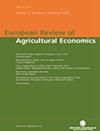Dynamically optimal cover crop adoption
IF 3.5
2区 经济学
Q2 AGRICULTURAL ECONOMICS & POLICY
引用次数: 0
Abstract
This paper develops a stochastic dynamic programming model to investigate optimal cover crop adoption policies, accounting for cumulative effects on soil fertility, uncertain future fertilizer and output prices, irreversibility of sunk machinery costs and flexibility in the timing of adoption over time. Based on data from a 35-year cotton field experiment in West Tennessee (1984–2018), we first estimate the static and dynamic yield effects of cover crop adoption and then use these estimates to evaluate the decision of a representative cotton farmer to adopt three cover cropping practices—hairy vetch, winter wheat and crimson clover—under conventional till and no-till production systems. Econometric estimates imply significant cumulative effects of cover crops on yields, as well as static and dynamic substitution effects between cover crops and nitrogen fertilizer inputs. With these substitution effects implying increasing marginal profit from soil fertility, our analysis suggests a threshold level of soil fertility level, above which it is optimal to adopt cover crops and below which it is not. Adoption of cover crops is more favored if no-till practices have been implemented. Moreover, in the presence of sunk costs that have not yet been incurred, the optimal strategy is to postpone the adoption of cover crops in both conventional till and no-till fields until crop prices improve, the cost of adoption decreases, or fertilizer prices increase. Our results also indicate that when fertilizer prices are higher, cover crop adoption in no-till systems can lead to substantial fertilizer cost savings, with the amount of those fertilizer cost savings increasing over time as soil health further improves.动态最优覆盖作物采用
本文开发了一个随机动态规划模型来研究最优覆盖作物采用政策,该模型考虑了对土壤肥力的累积效应、未来肥料和产出价格的不确定性、沉没机械成本的不可逆性以及随着时间的推移采用时间的灵活性。基于美国西田纳西州35年棉田试验数据(1984-2018),本文首先估算了采用覆盖作物的静态和动态产量效应,然后利用这些估算值评估了典型棉农在常规耕作和免耕生产制度下采用毛叶杨、冬小麦和深红色三叶草三种覆盖作物的决策。计量经济学估计表明覆盖作物对产量有显著的累积效应,以及覆盖作物与氮肥投入之间的静态和动态替代效应。由于这些替代效应意味着土壤肥力的边际利润增加,我们的分析提出了土壤肥力水平的一个阈值水平,高于该阈值水平是采用覆盖作物的最佳选择,低于该阈值水平则不是。如果实行免耕,则更倾向于采用覆盖作物。此外,在尚未发生沉没成本的情况下,最优策略是在传统耕作和免耕作领域推迟采用覆盖作物,直到作物价格改善、采用成本降低或肥料价格上涨。我们的研究结果还表明,当肥料价格较高时,在免耕系统中采用覆盖作物可以节省大量的肥料成本,随着土壤健康的进一步改善,这些肥料成本的节省量会随着时间的推移而增加。
本文章由计算机程序翻译,如有差异,请以英文原文为准。
求助全文
约1分钟内获得全文
求助全文
来源期刊

European Review of Agricultural Economics
管理科学-农业经济与政策
CiteScore
6.60
自引率
5.90%
发文量
25
审稿时长
>24 weeks
期刊介绍:
The European Review of Agricultural Economics serves as a forum for innovative theoretical and applied agricultural economics research.
The ERAE strives for balanced coverage of economic issues within the broad subject matter of agricultural and food production, consumption and trade, rural development, and resource use and conservation. Topics of specific interest include multiple roles of agriculture; trade and development; industrial organisation of the food sector; institutional dynamics; consumer behaviour; sustainable resource use; bioenergy; agricultural, agri-environmental and rural policy; specific European issues.
Methodological articles are welcome. All published papers are at least double peer reviewed and must show originality and innovation. The ERAE also publishes book reviews.
 求助内容:
求助内容: 应助结果提醒方式:
应助结果提醒方式:


